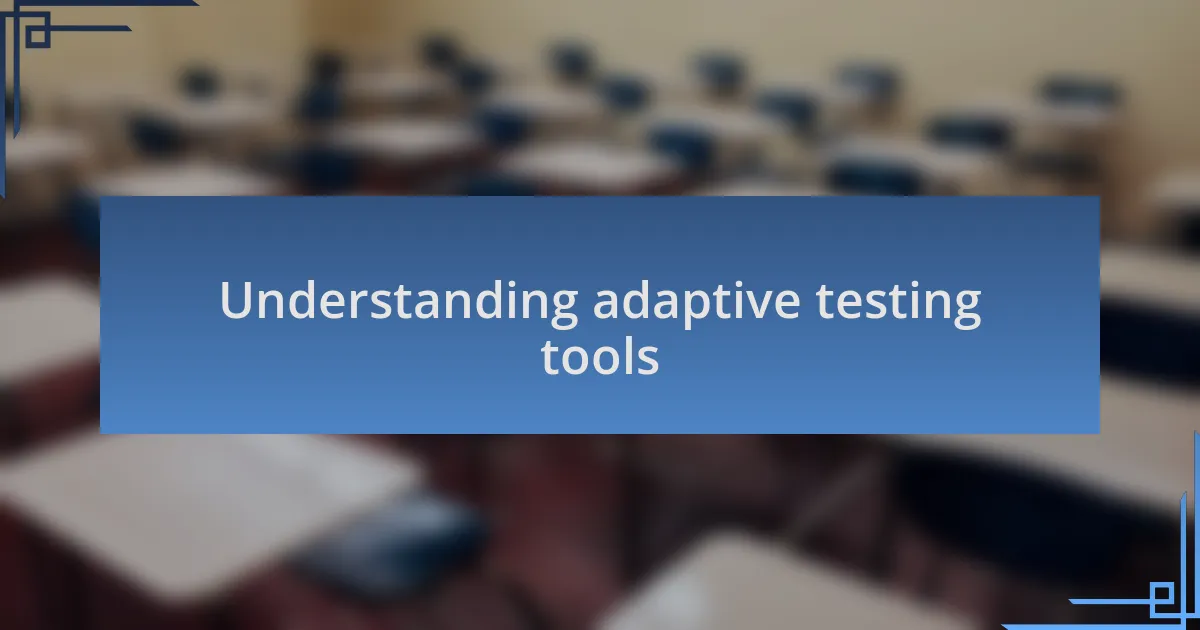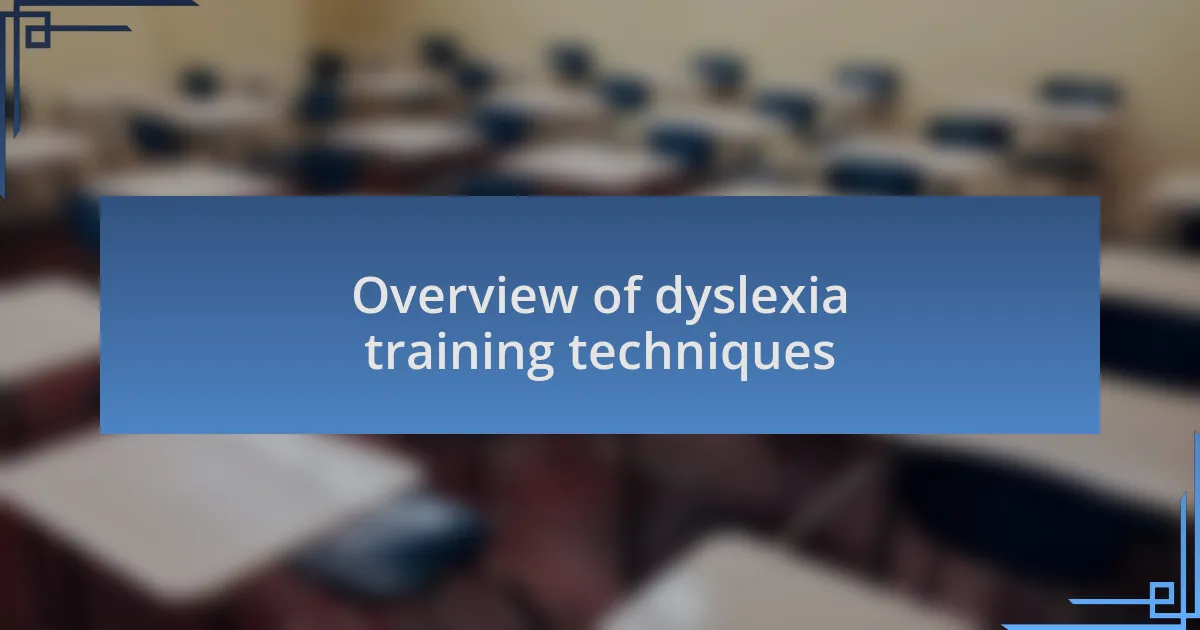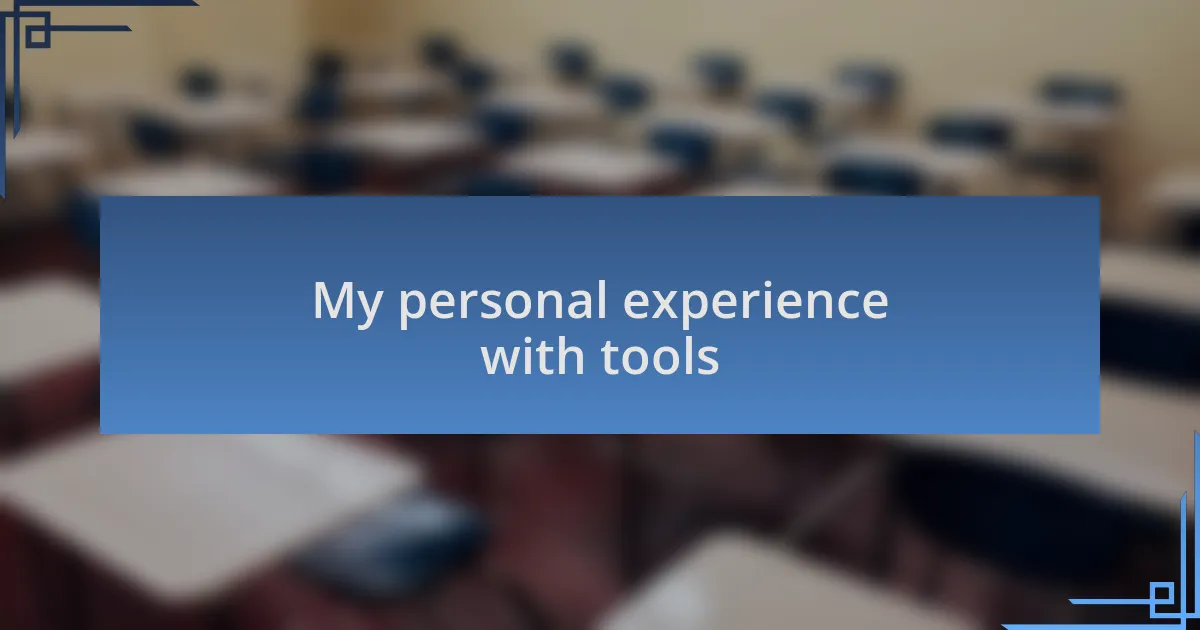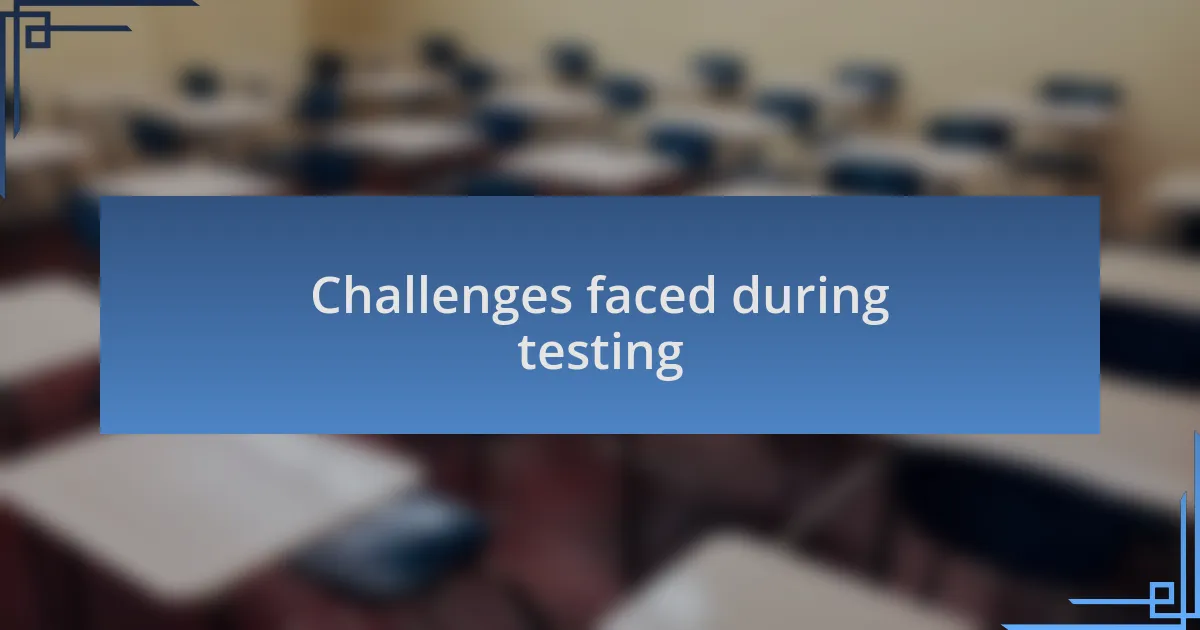Key takeaways:
- Adaptive testing tools provide a personalized learning experience by adjusting difficulty based on individual responses, enhancing engagement and autonomy.
- Dyslexia training techniques, such as multisensory instruction and phonemic awareness, significantly improve comprehension and confidence in learners.
- Immediate feedback from adaptive assessments helps learners identify strengths and weaknesses, fostering a positive self-perception and motivation to improve skills.
- Challenges with technology and emotional pressure during adaptive testing can hinder performance, necessitating strategies to manage anxiety and technical issues.

Understanding adaptive testing tools
Adaptive testing tools are designed to adjust the level of difficulty in real-time based on a learner’s responses, creating a customized experience for each individual. I remember my first encounter with such a tool; it felt like having a personal tutor who understood my strengths and weaknesses instantly. I could engage more deeply with the content because it was tailored just for me.
One of the most interesting aspects of adaptive testing is its ability to identify not just what a learner knows, but also how they process information. I often found myself reflecting on why certain questions were easier for me, while others felt like a brick wall. This insight helped me understand my learning patterns in ways I hadn’t considered before.
Moreover, these tools foster a sense of autonomy and motivation. When I realized that I could progress at my own pace, I was encouraged to push through challenging topics. Isn’t it empowering to know that the learning environment can adapt to fit you? It made my journey through dyslexia training feel much more achievable and less daunting.

Overview of dyslexia training techniques
Dyslexia training techniques offer a range of approaches tailored to support diverse learning needs. For example, multisensory instruction actively engages multiple senses to enhance comprehension—like when I practiced reading by tracing letters in sand while saying the sounds aloud. This hands-on experience made the letters come alive, transforming what felt like a chore into something interactive and enjoyable.
Another effective technique I encountered is phonemic awareness training, which focuses on helping learners identify and manipulate sounds in words. Initially, grappling with blending sounds felt overwhelming, similar to trying to untangle a mess of yarn. However, as I honed this skill, I began to experience a profound “aha” moment when I could read new words with confidence, sparking a newfound motivation to tackle even more challenging texts.
Additionally, using visual supports, such as colored overlays or graphic organizers, can significantly aid in processing written information. I remember how a simple color-coded system helped me differentiate between different types of information, making it easier to follow along. Have you ever noticed how visual cues can change your understanding? It’s remarkable how these seemingly small adjustments can create a more accessible learning environment, helping individuals with dyslexia navigate their reading journey more smoothly.

Benefits of using adaptive testing
Adaptive testing offers a personalized approach that can significantly enhance the learning experience for individuals with dyslexia. I remember my initial struggle with traditional assessments; they often felt like one-size-fits-all solutions that didn’t cater to my unique needs. With adaptive testing, the questions adjust based on my responses, which not only reduces frustration but also allows me to demonstrate my true capabilities.
Another significant benefit of adaptive testing is its ability to identify specific areas of strength and weakness. I had moments where I thought I was solely bad at reading comprehension, but through adaptive assessments, I discovered I actually excelled in certain areas, like vocabulary. This revelation shifted my self-perception and motivated me to focus on building my skills, rather than feeling defeated by my challenges.
Moreover, the immediate feedback provided by adaptive testing can instill a sense of confidence and progress. I recall a time when I completed an adaptive assessment and, upon seeing my results, felt a rush of pride at how far I had come. Have you had those moments where feedback transforms your understanding? It’s empowering to see growth reflected in real-time, reinforcing the journey toward mastering reading skills in a way that’s both encouraging and constructive.

My personal experience with tools
When I first explored adaptive testing tools, I felt a mix of curiosity and skepticism. The concept of a test adapting to my responses seemed almost too good to be true. But as I engaged with the tool, I quickly realized how the tailored questions helped me connect better with the material; it was like speaking a language that finally made sense.
One vivid memory stands out: I was taking an adaptive reading assessment, and suddenly, I was faced with a narrative that had me intrigued. The questions following it seemed perfectly attuned to my understanding, challenging yet approachable. This moment made me think—how often do we get an opportunity to learn in such a relevant way? It sparked a joy in me that I hadn’t felt in traditional tests, guiding my focus toward what truly mattered.
Additionally, the moment I began using these tools, I found that learning could actually feel enjoyable. There were days when I would log on just to see how much progress I’d made, checking my stats like I was monitoring a game score. Did you ever feel that thrill when you realized you were getting better? Those little achievements transformed my experience from one of anxiety to one of achievement, giving me a newfound motivation to keep pushing forward.

Challenges faced during testing
As I delved into adaptive testing, I encountered a significant challenge: the tool’s reliance on technology. At times, the system would glitch, leading to lost data or interrupted assessments. I remember one frustrating instance where I lost nearly an hour of work because the platform crashed. Has that ever happened to you? It’s disheartening, especially when you’re in the groove of your learning.
Another hurdle was the varied pacing of questions. While I appreciated adaptive tests adjusting to my abilities, certain questions felt too rushed. I would often find myself stuck trying to comprehend the nuances of a question while the timer ticked down. This pressure can be overwhelming. I asked myself, how can one perform their best under such constraints?
Additionally, the emotional aspect of testing can’t be understated. I sometimes felt a surge of anxiety when faced with particularly tough questions, which, ironically, made it harder for me to concentrate. Have you ever experienced that? It’s like the weight of expectation can cloud your thoughts, making it difficult to navigate through the assessment. Learning to manage that anxiety became almost as integral as understanding the tool itself.